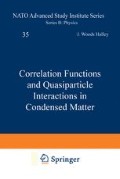Abstract
The possibility of using Raman scattering as a probe for studying the elementary excitations of superfluid helium was first suggested by Halley1 in 1968. Raman scattering in helium is a second order process in which two excitations of nearly equal and opposite momenta are created in the liquid. The spectrum of scattered light at an energy loss E is a measure of the density of two excitation states with zero total wavevector and energy E.1,2 The primary contribution comes from the roton region of the dispersion curve. At low temperatures this consists of a well defined line near E = 2Δ, where Δ is the energy of the roton minimum. I will concentrate on the 2-roton light scattering. A discussion of the spectrum in other energy regions can be found in reference 3.
Access this chapter
Tax calculation will be finalised at checkout
Purchases are for personal use only
Preview
Unable to display preview. Download preview PDF.
References
J.W. Halley, Bull. Am. Phys. Soc. 13, 398 (1968)
and J.W. Halley, Phys. Rev. 181, 338 (1969)
M.J. Stephen, Phys. Rev. 187, 279 (1969)
T.J. Greytak, Physics of Quantum Fluids, 1970, Tokyo Summer Lectures in Theoretical and Experimental Physics. R. Kubo and F. Takano, editors (Tokyo, Syokabo)
T.J. Greytak and J. Yan, Phys. Rev. Lett. 22, 987 (1969)
J. Ruvalds and A. Zawadowsky, Phys. Rev. Lett. 25, 333 (1970)
F. Iwamoto, Prog. of Theoretical Phys. (Japan) 44, 1135 (1970)
T.J. Greytak, R. Woerner, J. Yan, and R. Benjamin, Phys. Rev. Lett. 25, 1547 (1970)
R.A. Cowley and A.D.B. Woods, Can. J. Phys. 49, 177 (1971)
C.A. Murray, R.L. Woerner, and T.J. Greytak, J. Phys. C: Solid State Phys. 8, L90 (1975)
R.L. Woerner and T.J. Greytak, Rev. Sci. Ins. 47, 383 (1976)
A.D.B. Woods, P.A. Hilton, R. Scherm, and W.G. Stirling, J. Phys. C: Solid State Phys. 10, L45 (1977)
R.L. Woerner and M.J. Stephen, J. Phys. C: Solid State Phys. 8, L464 (1975)
R.A. Cowley, J. Phys. C: Solid State Phys. 5, L287 (1972)
D. Baeriswyl, Phys. Lett. 41A, 297 (1972)
Author information
Authors and Affiliations
Editor information
Editors and Affiliations
Rights and permissions
Copyright information
© 1978 Plenum Press, New York
About this chapter
Cite this chapter
Murray, C.A. (1978). Two Roton Raman Scattering in Superfluid He4 . In: Halley, J.W. (eds) Correlation Functions and Quasiparticle Interactions in Condensed Matter. NATO Advanced Study Institutes Series, vol 35. Springer, Boston, MA. https://doi.org/10.1007/978-1-4684-3360-9_17
Download citation
DOI: https://doi.org/10.1007/978-1-4684-3360-9_17
Publisher Name: Springer, Boston, MA
Print ISBN: 978-1-4684-3362-3
Online ISBN: 978-1-4684-3360-9
eBook Packages: Springer Book Archive

